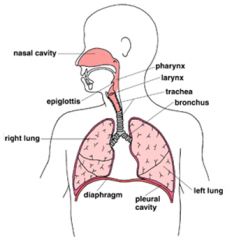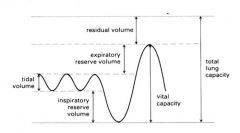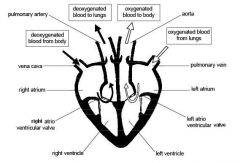![]()
![]()
![]()
Use LEFT and RIGHT arrow keys to navigate between flashcards;
Use UP and DOWN arrow keys to flip the card;
H to show hint;
A reads text to speech;
12 Cards in this Set
- Front
- Back
|
Question 1 and 2 - Applied Anatomy and Physiology |
Respiration System: Mechanics of breathing and how it works.
|
|

Diagram of Respiratory organs - bronchus leads to bronchioles leads to alveoli. |
Tidal Volume - the amount of air breathed in and out in one breath. Inspiratory Reserve Volume - the air that is reserved once you have breathed in your largest breath possible. Expiratory Reserve Volume - the air that can be forcibly expired after the tidal volume.
|
|
|
Total Lung Capacity - This is the vital lung capacity plus the residual volume and is the total amount of air the lungs can hold. Residual Volume - The amount of air left in the lungs following a maximal exhalation. There is always some air remaining to prevent the lungs from collapsing. |
Vital Capacity - The most air you can exhale after taking the deepest breath you can. It can be up to ten times more than you would normally exhale. |
|

Spirometer Trace |

Diagram of the Heart |
|
|
Heart Dynamics: Stroke Volume - The blog leaving the left ventricle per beat Heart Rate - Amount of heart beats per beat Cardiac Output - Stroke Volume x Heart Rate - Volume of blood pumped out of the heart per minute
|
Cardiac Output = SV x HR (Q) |
|
|
Venous Return: The return of blood to the heart (2 functions)
|
1. Muscle Pump - Contraction of the skeletal muscles exerts pressure on veins forcing blood to flow towards the heart. 2. Respiratory Pump - During inspiration, the pressure in thoracic activity decreases. Pressure in abdominal cavity increase. Blood moves up from compressed high pressure to low pressure |
|
|
How does an efficient venous return system benefit an endurance athlete? Efficient venous return is important as the deoxygenated blood needs to get back to the heart to increase cardiac output for the endurance athlete. The stretching of the left ventricle causes an recoil of the blood back out of the heart. |
Starlings Law - the greater the venous return, the greater the stroke volume. |
|
|
Gaseous Exchange: Diffusion - the transition from the capillary to the air sacs. Porous - Holes to let oxygen in and CO2 out Partial Pressure - The individual pressure that the gas exerts when it occurs in a mixture of gases. Pressure Gradient: The difference in partial pressure in an area of high conc. to low conc. |
Haemoglobin - Pigment in red blood cell where the oxygen gets carried. Haemoglobin has an affinity to oxygen. Myoglobin - Where the oxygen is attracted/affininate in muscle site Capillary - Air leaves blood in capillary into alveolus to be oxygenated and diffuses back out |
|
|
Alveoli - Air sacs in the lungs where the air goes into to be oxygenated Blood Plasma - Watery substance in our blood. CO2 is dissolved into blood plasma where it is carried round the blood. Dissociation curve - expresses haemoglobin's affinity to oxygen in the alveoli and capillary. |
Surface Area - the larger the surface area, the greater the rate of diffusion. A - VO2 Difference - the difference between the amount of O2 carried in the arteries and veins. |
|
|
Alevoli: - moist, thin walls - only one cell thick: allows the gases to diffuse from capillaries to alveoli - large surface area: faster rate of diffusion - Good blood supply: blood is constantly taking oxygen away and adding more carbon dioxide |
Oxygen and carbon dioxide move across a pressure gradient. The oxygen moves from an area of high pressure in the lungs to an area of low pressure in the capillaries. |
|
|
Control of Heart Rate: Myogenic - generates it's own electrical impulses Sino-artrial Node - initiates impulse for contraction through two mechanisms which control the speed of the heart - Neural Control Mechanism - Hormonal Control Mechanism |
Atrio-ventricular Node - bundle of tissue found in the atrio-ventricular septum that forms part of heart's conduction system Bundle of His - Specialised bundles of nerve tissue, found in the inter ventricular septum that forms part of the conduction system. |
|
|
Purkinje Fibres - specialised nerve fibres found in the ventricles
Ejection Fraction - proportion of blood in the left ventricle pumped out each beat |
Use Starling's law' to explain how stroke volume increases when running: Starling's law stated the greater the venous return, the greater the strength of contraction this links to the increase in stroke volume which increases the recoil from the left ventricle out to the body. |

